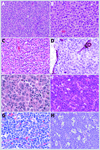The histological and biological spectrum of diffuse large B-cell lymphoma in the World Health Organization classification
- PMID: 23006945
- PMCID: PMC3458515
- DOI: 10.1097/PPO.0b013e31826aee97
The histological and biological spectrum of diffuse large B-cell lymphoma in the World Health Organization classification
Abstract
Diffuse large B-cell lymphomas (DLBCLs) are aggressive B-cell lymphomas that are clinically, pathologically, and genetically diverse, in part reflecting the functional diversity of the B-cell system. The focus in recent years has been toward incorporation of clinical features, morphology, immunohistochemistry, and ever evolving genetic data into the classification scheme. The 2008 World Health Organization classification reflects this complexity with the addition of several new entities and variants. The discovery of distinct subtypes by gene expression profiling heralded a new era with a focus on pathways of transformation as well as a promise of more targeted therapies, directed at specific pathways. Some DLBCLs exhibit unique clinical characteristics with a predilection for specific anatomic sites; the anatomic site often reflects underlying biological distinctions. Recently, the spectrum of Epstein-Barr virus (EBV)-driven B-cell proliferations in patients without iatrogenic or congenital immunosuppression has been better characterized; most of these occur in patients of advanced age and include Epstein-Barr virus (EBV)-positive large B-cell lymphoma of the elderly. Human herpesvirus 8 is involved in the pathogenesis of primary effusion lymphoma, which can present as a "solid variant." Two borderline categories were created; one deals with tumors at the interface between classic Hodgkin lymphoma and DLBCL. The second confronts the interface between Burkitt lymphoma and DLBCL, so-called "B-cell lymphoma, unclassifiable, with features intermediate between DLBCL and Burkitt lymphoma" in the 2008 classification. Most cases harbor both MYC and BCL2 translocations and are highly aggressive. Another interesting entity is anaplastic lymphoma kinase-positive DLBCL, which renders itself potentially targetable by anaplastic lymphoma kinase inhibitors. Ongoing investigations at the genomic level, with both exome and whole-genome sequencing, are sure to reveal new pathways of transformation in the future.
Figures



References
-
- Saito M, Gao J, Basso K, et al. A signaling pathway mediating downregulation of BCL6 in germinal center B cells is blocked by BCL6 gene alterations in B cell lymphoma. Cancer Cell. 2007 Sep;12(3):280–292. - PubMed
-
- Dunleavy K, Pittaluga S, Wayne As, et al. MYC + aggressive-B-cell lymphomas: novel therapy of untreated Burkitt lymphoma (BL) AND MYC + Diffuse large B-cell lymphoma (DLBCL) WITH DA-EPOCH-R. Ann Oncol. 2011;22(suppl 4):106.
-
- Savage KJ, Johnson NA, Ben-Neriah S, et al. MYC gene rearrangements are associated with a poor prognosis in diffuse large B-cell lymphoma patients treated with R-CHOP chemotherapy. Blood. 2009 Oct 22;114(17):3533–3537. - PubMed
Publication types
MeSH terms
Grants and funding
LinkOut - more resources
Full Text Sources
Medical

